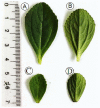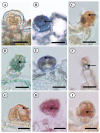Morphoanatomical, Histochemical, and Essential Oil Composition of the Plectranthus ornatus Codd. (Lamiaceae)
- PMID: 37764258
- PMCID: PMC10536712
- DOI: 10.3390/molecules28186482
Morphoanatomical, Histochemical, and Essential Oil Composition of the Plectranthus ornatus Codd. (Lamiaceae)
Abstract
Plectranthus ornatus is a medicinal and aromatic plant used in traditional and alternative medicine. In this study, leaves of P. ornatus were collected in two cities of the state of Pará, "Quatipuru" and "Barcarena", and were used with the objective of analyzing, through morphoanatomical data and histochemical and phytochemical studies of essential oil, the samples present structural differences and differences in their chemical composition. Anatomical and histochemical analyses were performed by transverse, using longitudinal sections of 8 μm to 10 μm to perform epidermal dissociation, diaphonization, and tests to identify classes of secondary metabolites. The essential oils were isolated by hydrodistillation, and the identification of the chemical composition was performed by gas chromatography coupled with mass spectrometry. The anatomical study shows that there is no difference between specimens collected in different locations, and stellate trichomes were identified. The histochemical study detected total lipids and acids, terpenes, polysaccharides, phenolic compounds, tannins, alkaloids, and calcium oxalate. The low essential oil yield may be related to the low density of secretory cells (glandular trichomes), the unidentified compounds in the highest concentration in the essential oil were in relation to the chemical composition of the essential oils, and the major compounds were α-pinene, sabinene, (E)-caryophyllene, caryophyllene oxide, and oct-1-en-3-ol. The results provide new information about the anatomy and histochemistry of P. ornatus.
Keywords: anatomy; natural products; phytochemicals; volatile compounds.
Conflict of interest statement
The authors declare no conflict of interest.
Figures





References
-
- Zappi D.C., Filardi F.L.R., Leitman P., Souza V.C., Walter B.M.T., Pirani J.R., Morim M.P., Queiroz L.P., Cavalcanti T.B., Mansano V.F., et al. Growing Knowledge: An Overview of Seed Plant Diversity in Brazil. Rodriguésia. 2015;66:1085–1113. doi: 10.1590/2175-7860201566411. - DOI
-
- Khan M., Al-Saleem M.S.M., Alkhathlan H.Z. A Detailed Study on Chemical Characterization of Essential Oil Components of Two Plectranthus Species Grown in Saudi Arabia. J. Saudi Chem. Soc. 2016;20:711–721. doi: 10.1016/j.jscs.2016.03.006. - DOI
-
- Karakoti H., Mahawer S.K., Tewari M., Kumar R., Prakash O., de Oliveira M.S., Rawat D.S. Phytochemical Profile, In Vitro Bioactivity Evaluation, In Silico Molecular Docking and ADMET Study of Essential Oils of Three Vitex Species Grown in Tarai Region of Uttarakhand. Antioxidants. 2022;11:1911. doi: 10.3390/antiox11101911. - DOI - PMC - PubMed
-
- Karakoti H., Kabdal T., Kumar R., Prakash O., Rawat D.S., Srivastava R.M., Santana de Oliveira M. Chemical Composition, Biological Activities and In Silico Evaluation of Essential Oils from the Aerial, and Root Parts of Nepeta hindostana (B. Heyne Ex Roth)-Haines Grown in North India. Biochem. Syst. Ecol. 2022;105:104512. doi: 10.1016/j.bse.2022.104512. - DOI
-
- Arya S., Kumar R., Prakash O., Kumar S., Mahawer S.K., Chamoli S., Kumar P., Srivastava R.M., de Oliveira M.S. Chemical Composition and Biological Activities of Hedychium coccineum Buch.-Ham. Ex Sm. Essential Oils from Kumaun Hills of Uttarakhand. Molecules. 2022;27:4833. doi: 10.3390/molecules27154833. - DOI - PMC - PubMed
Grants and funding
LinkOut - more resources
Full Text Sources
Research Materials

